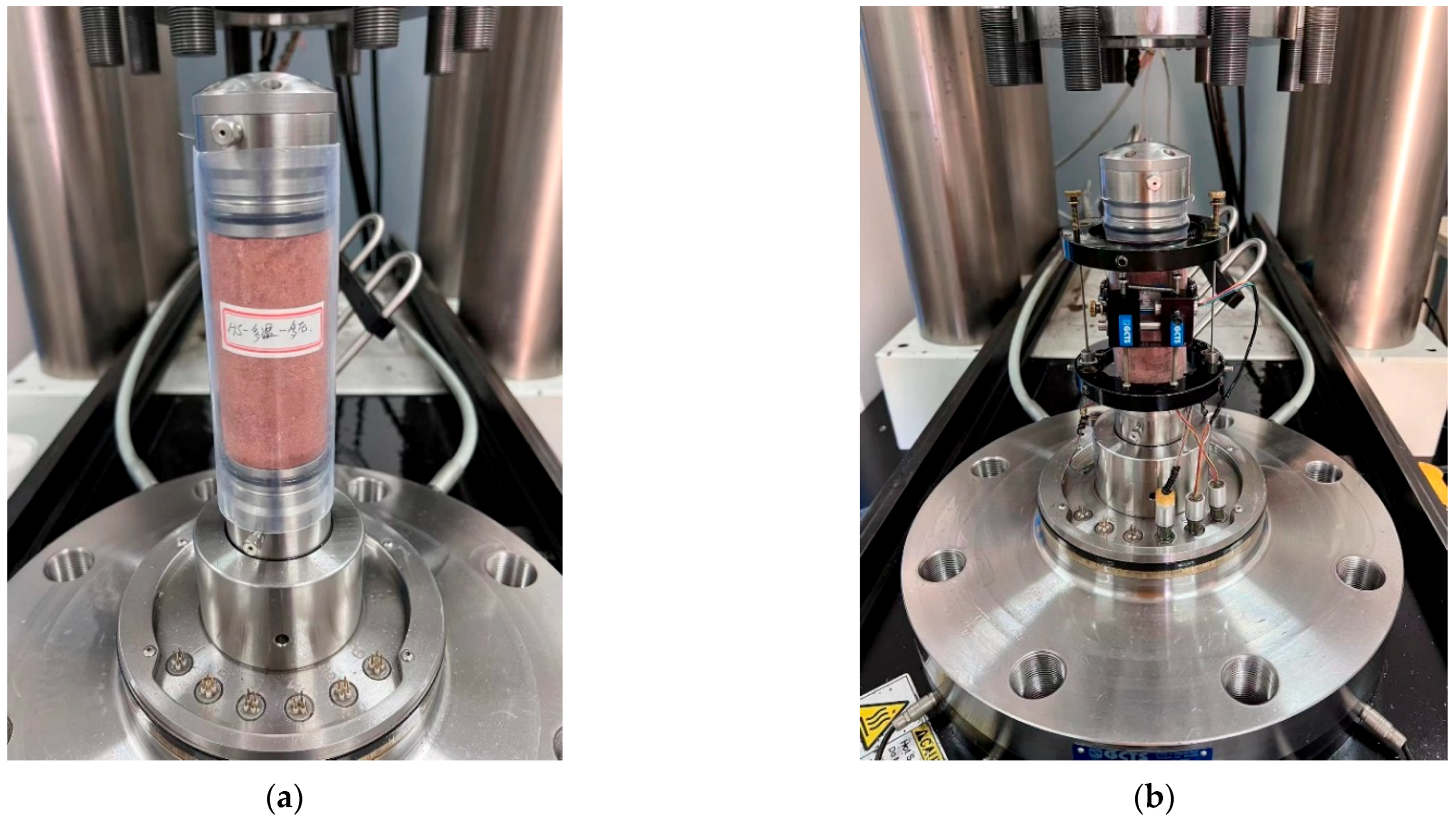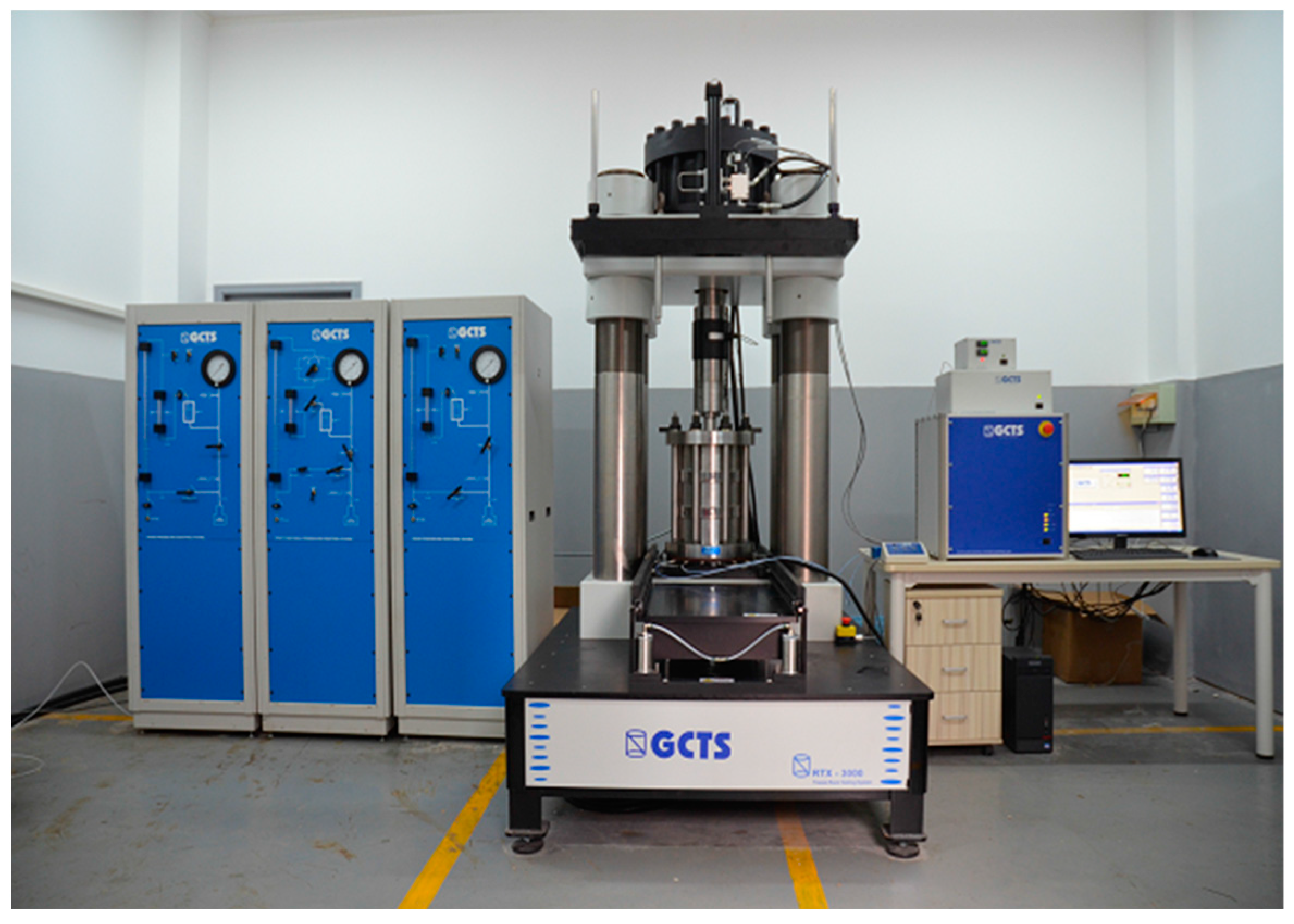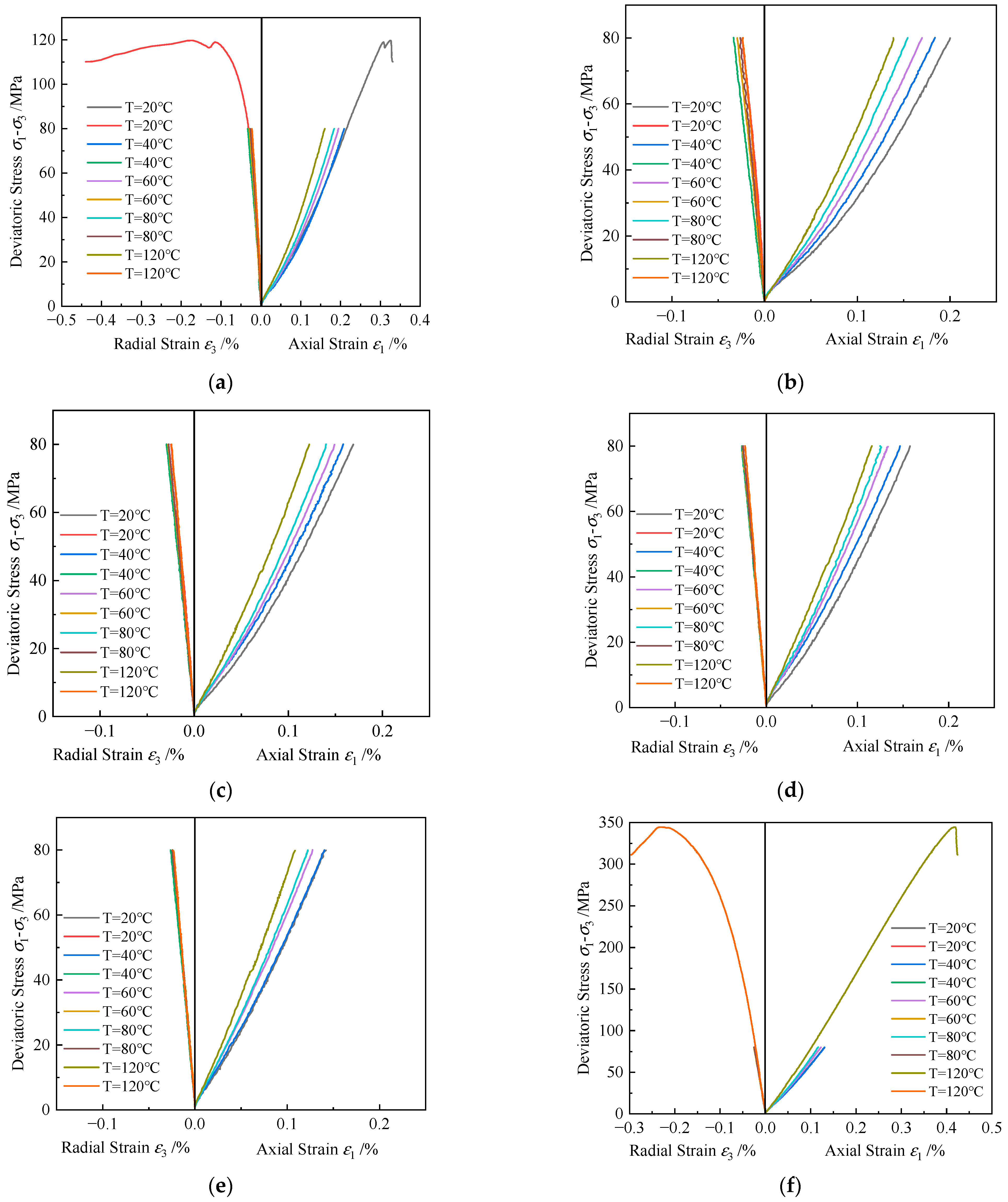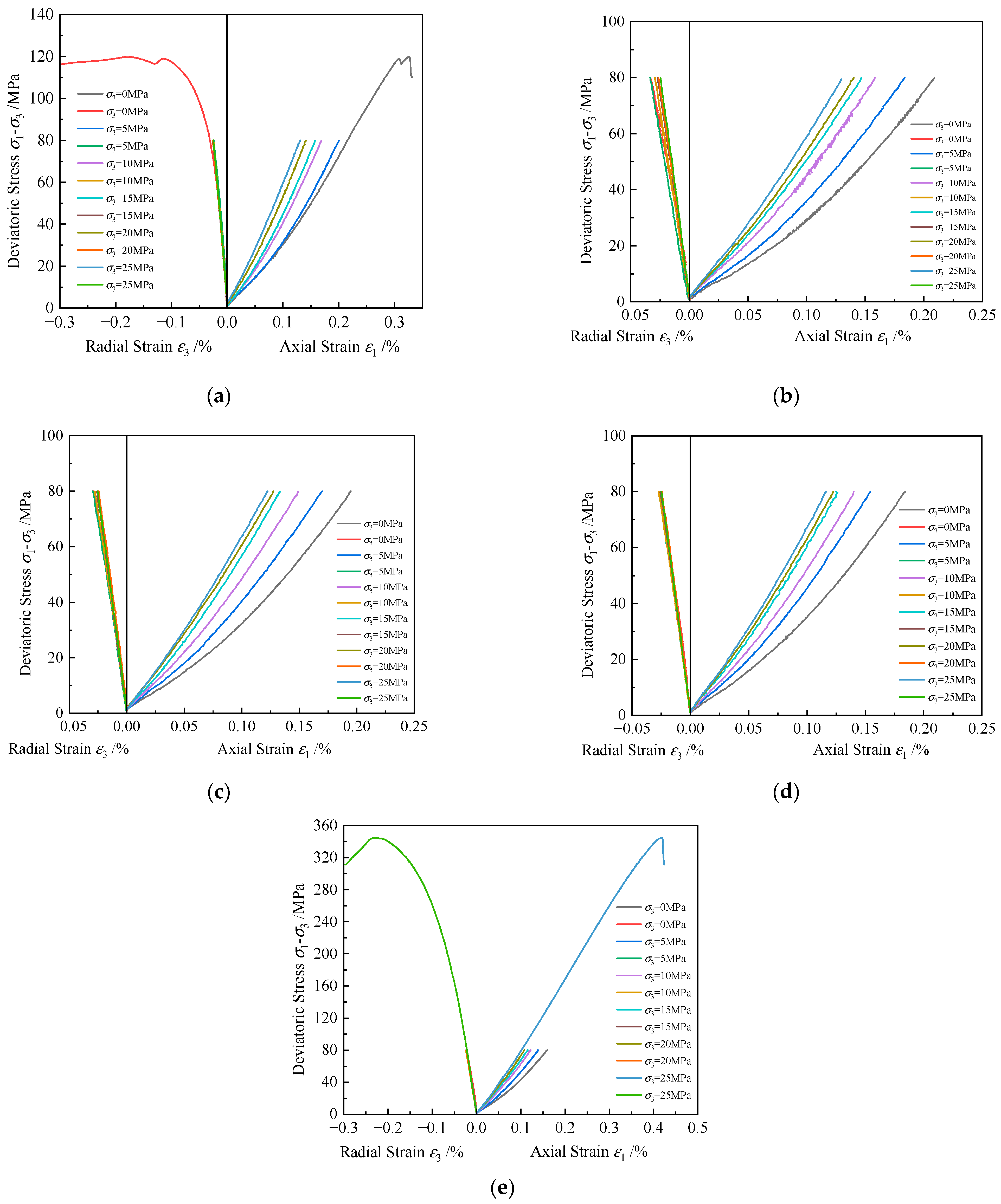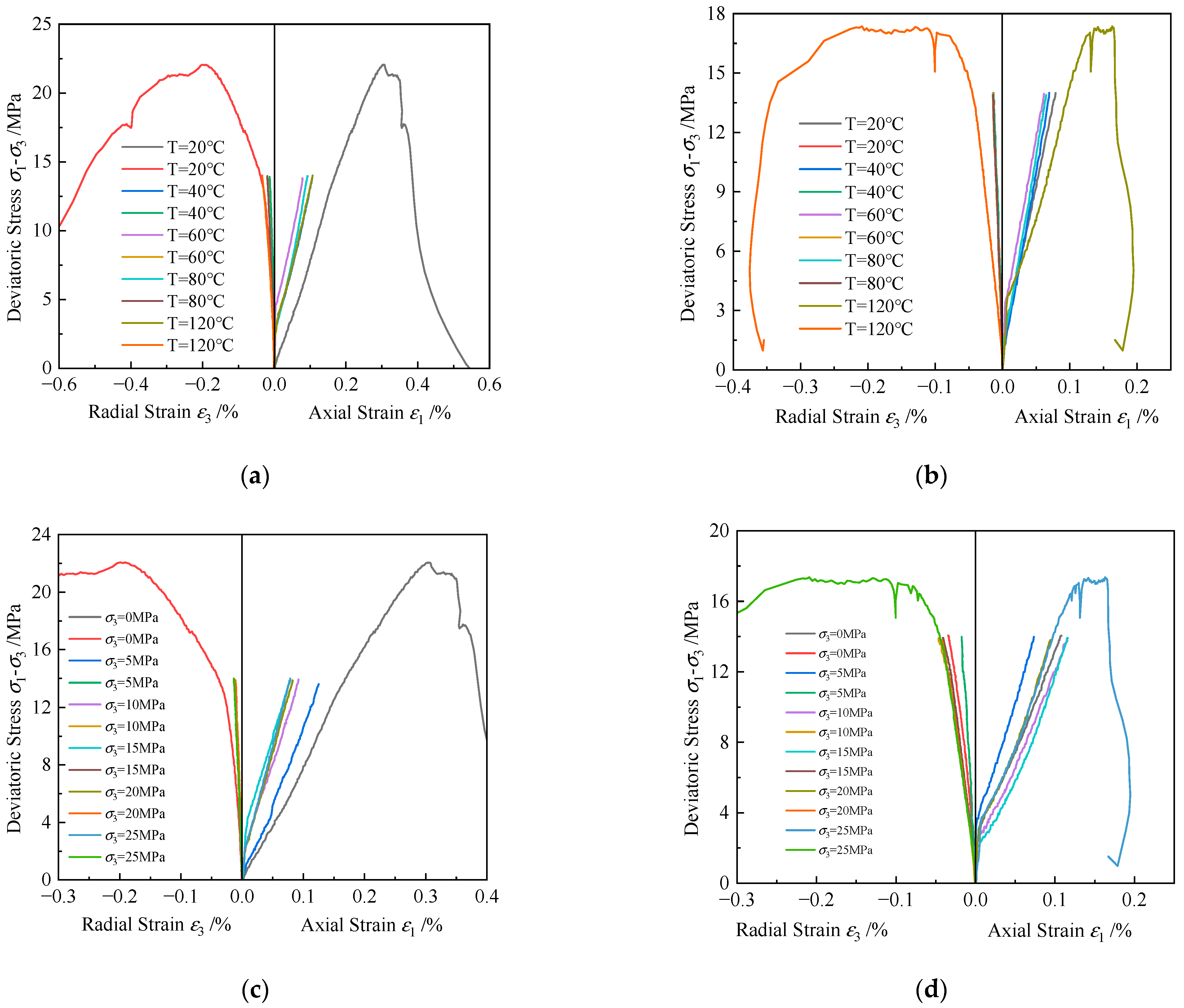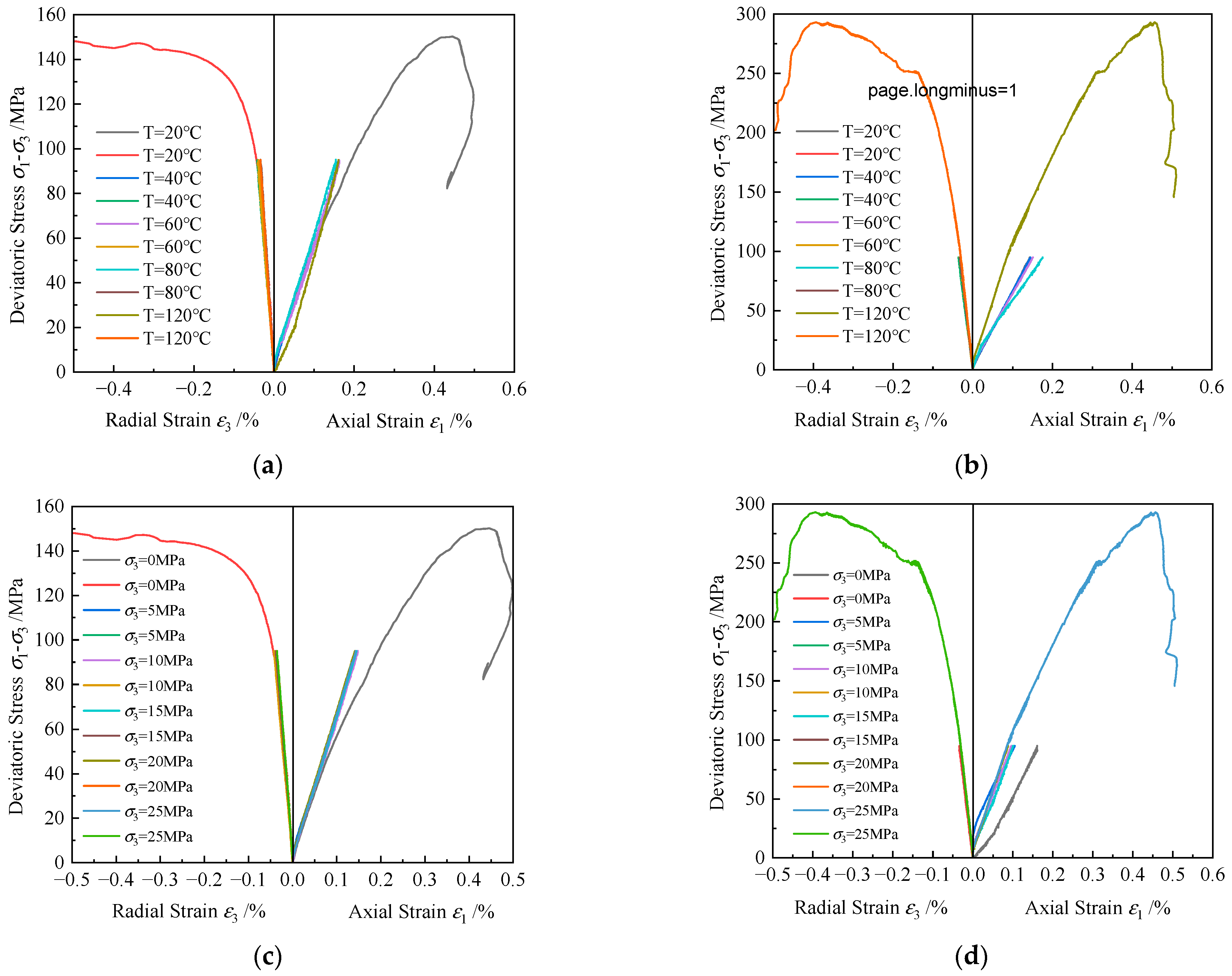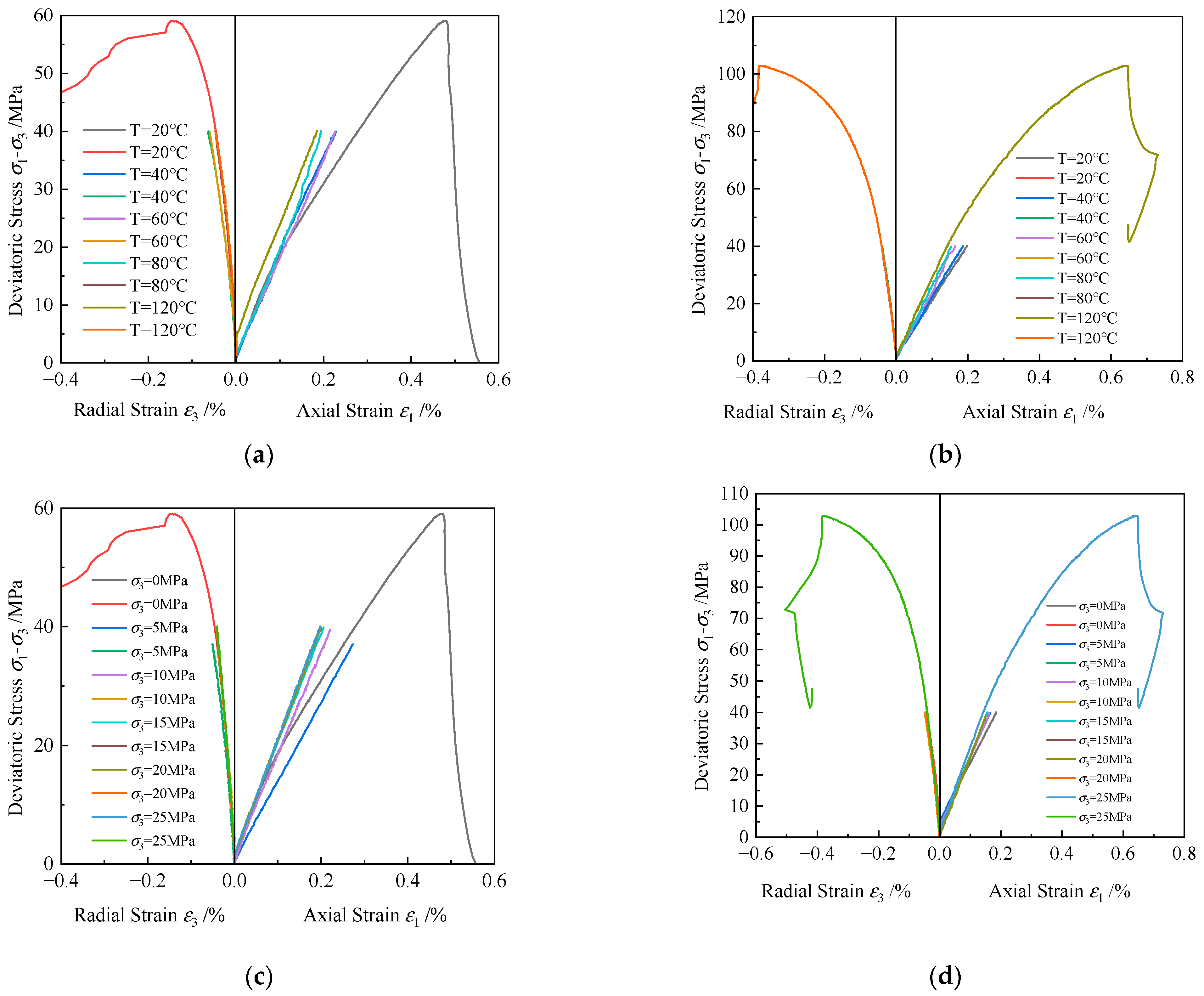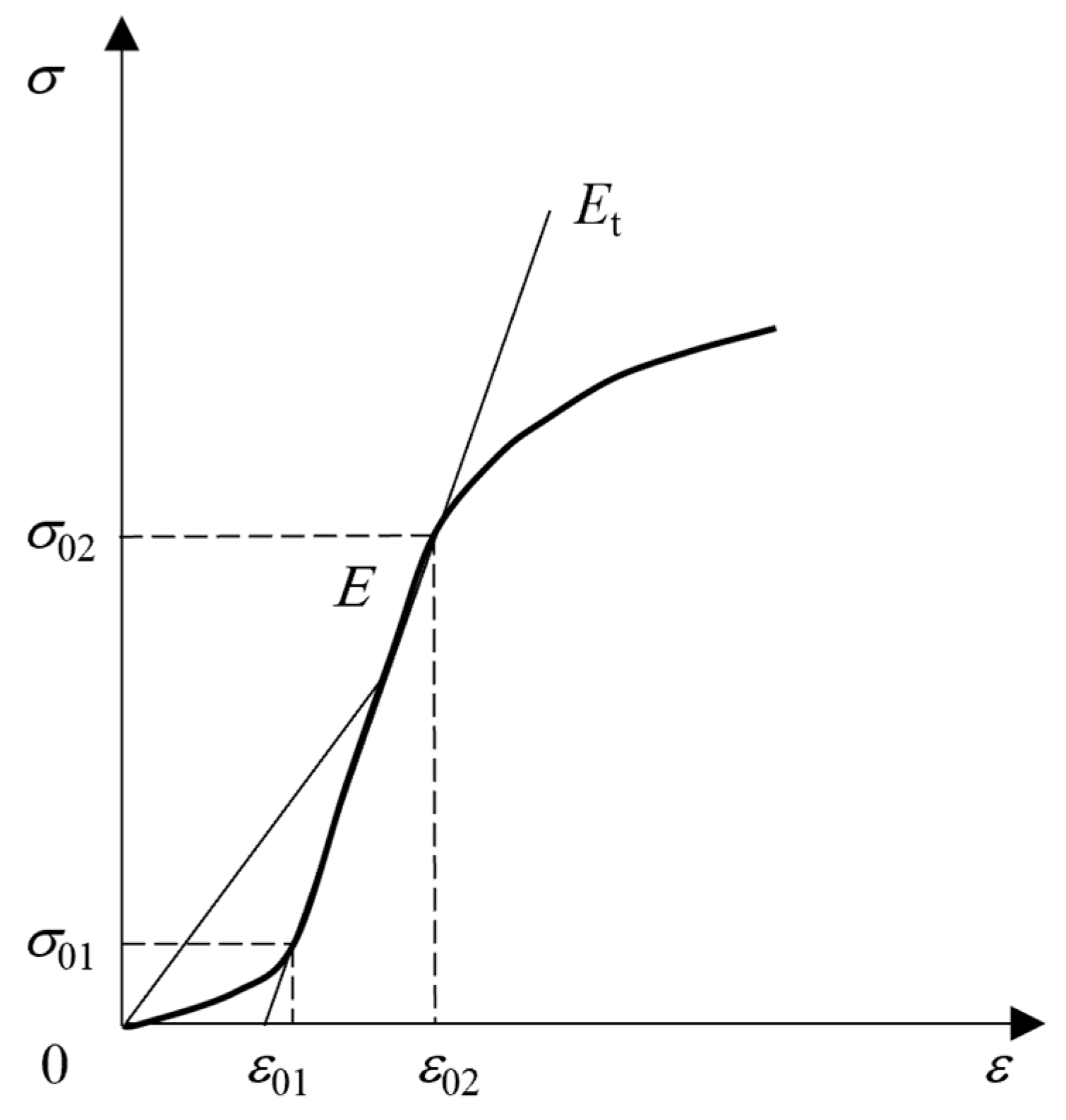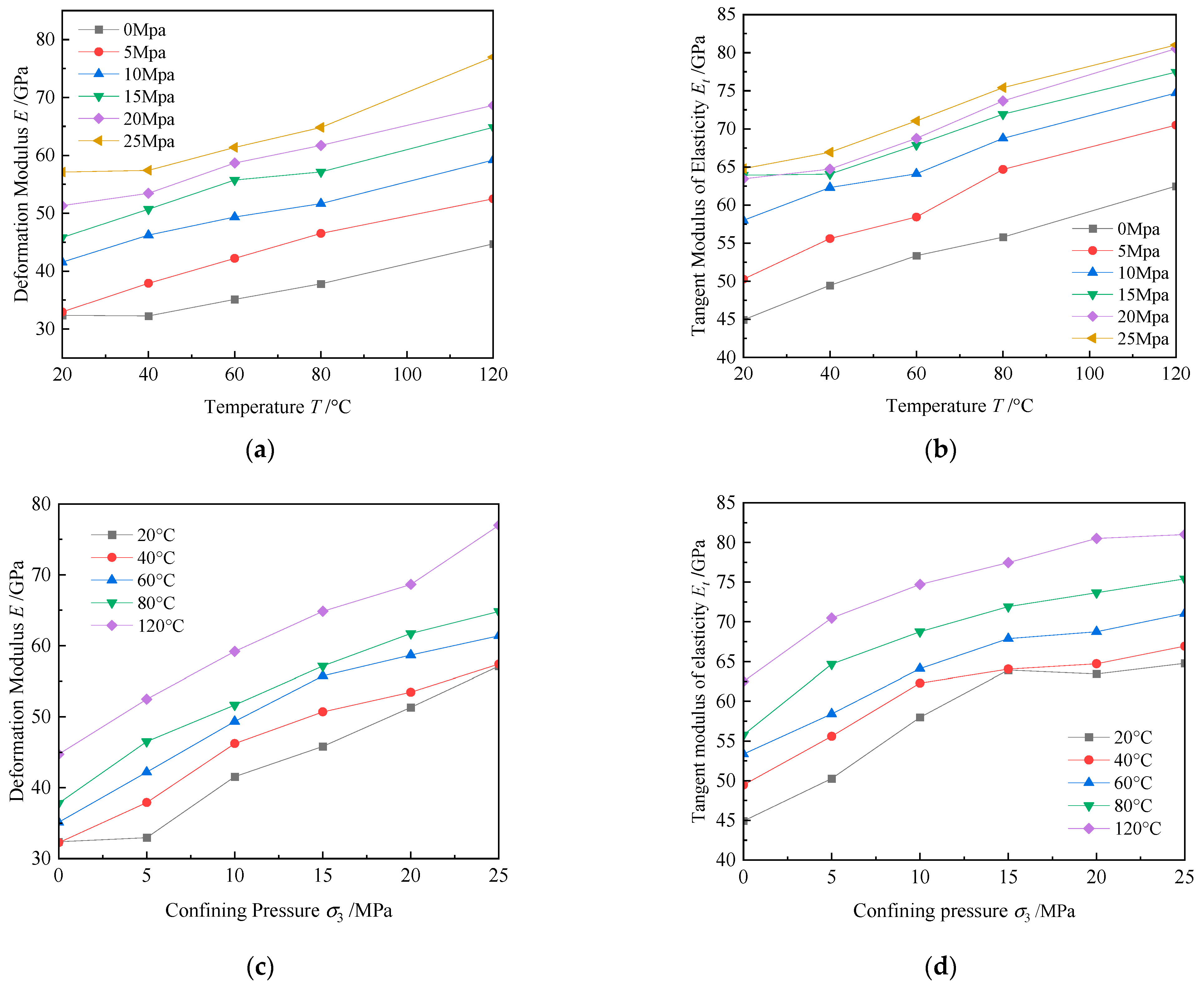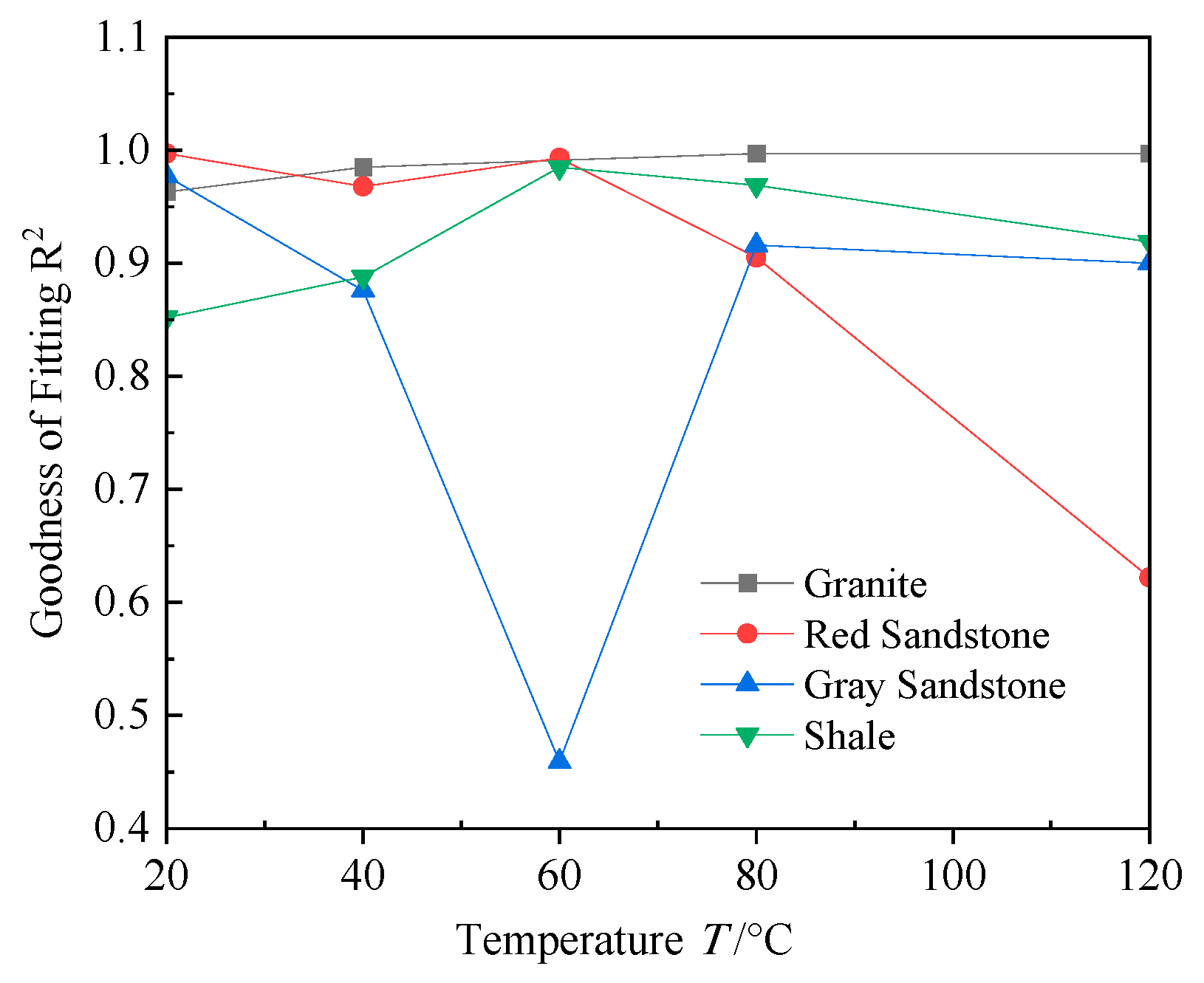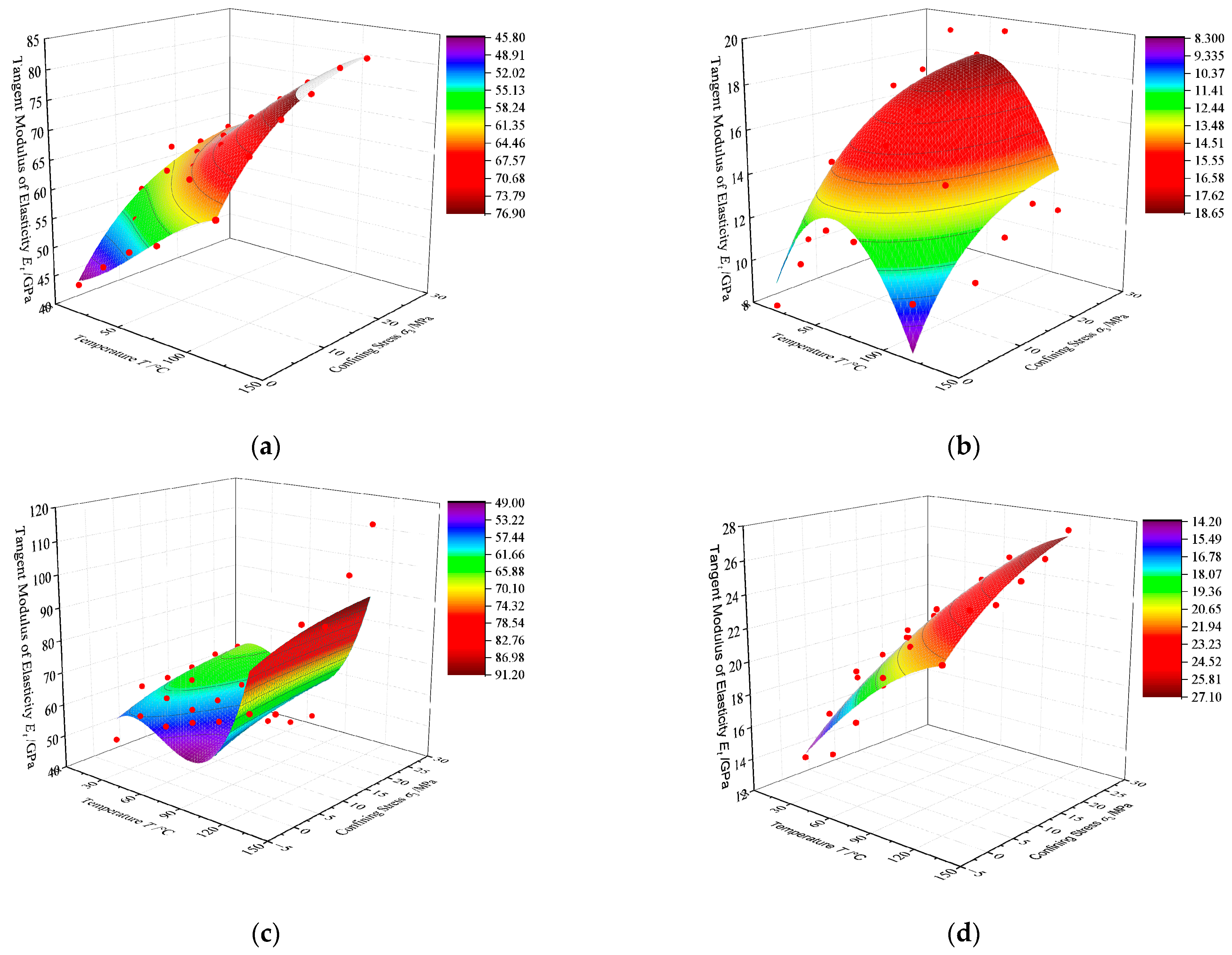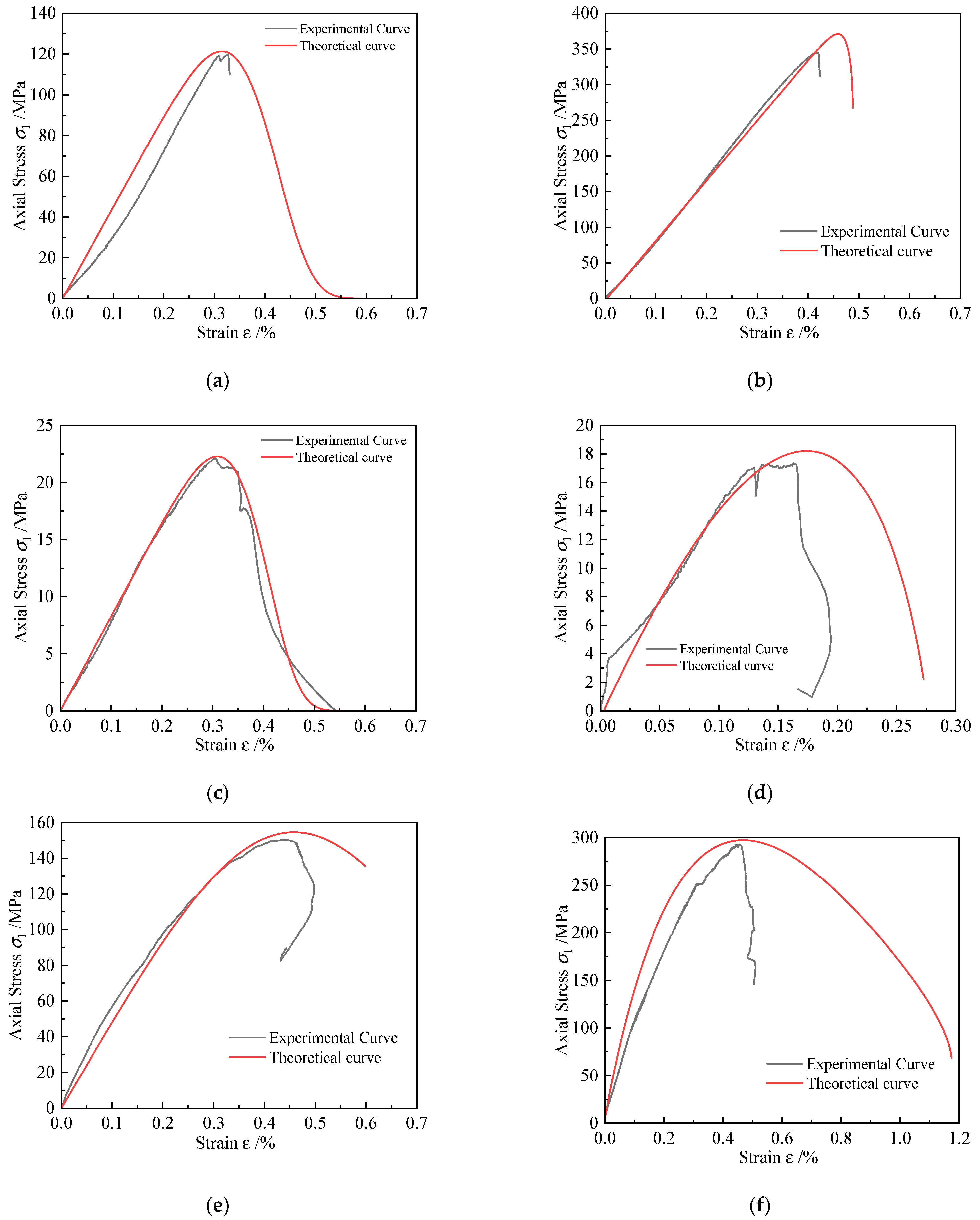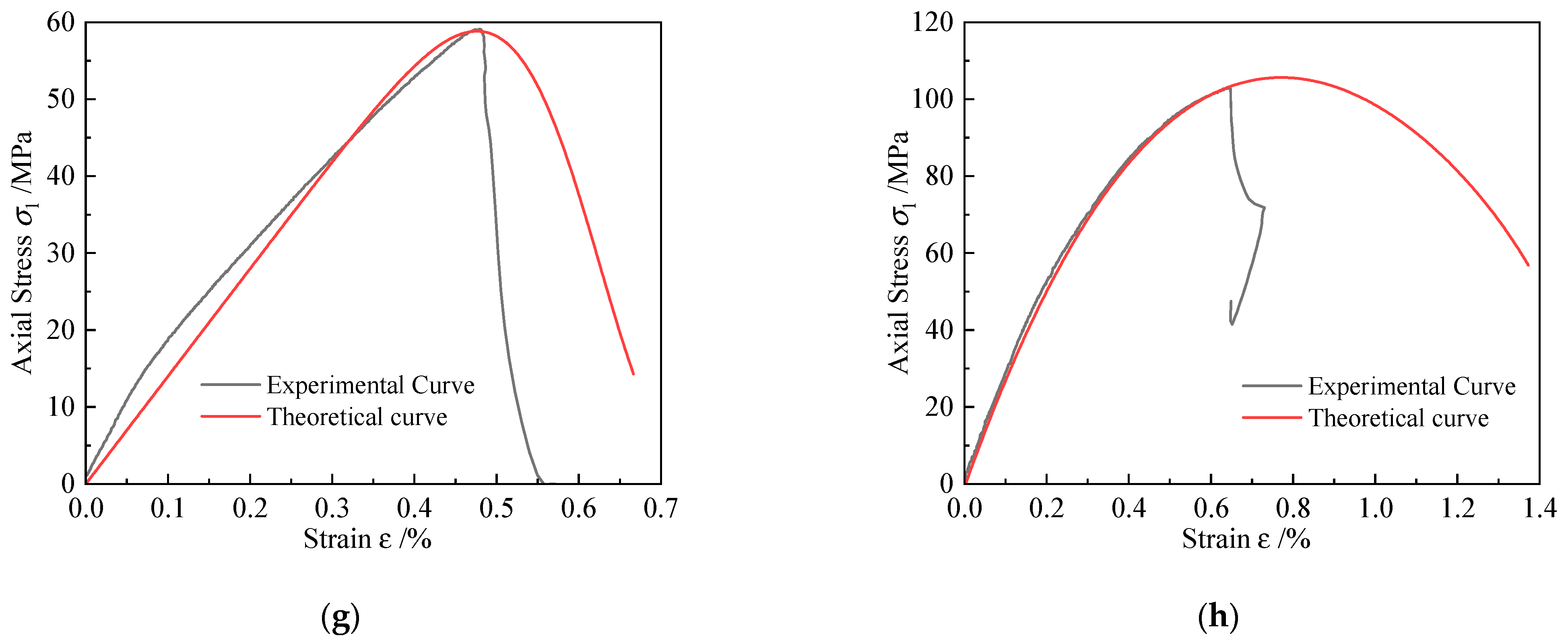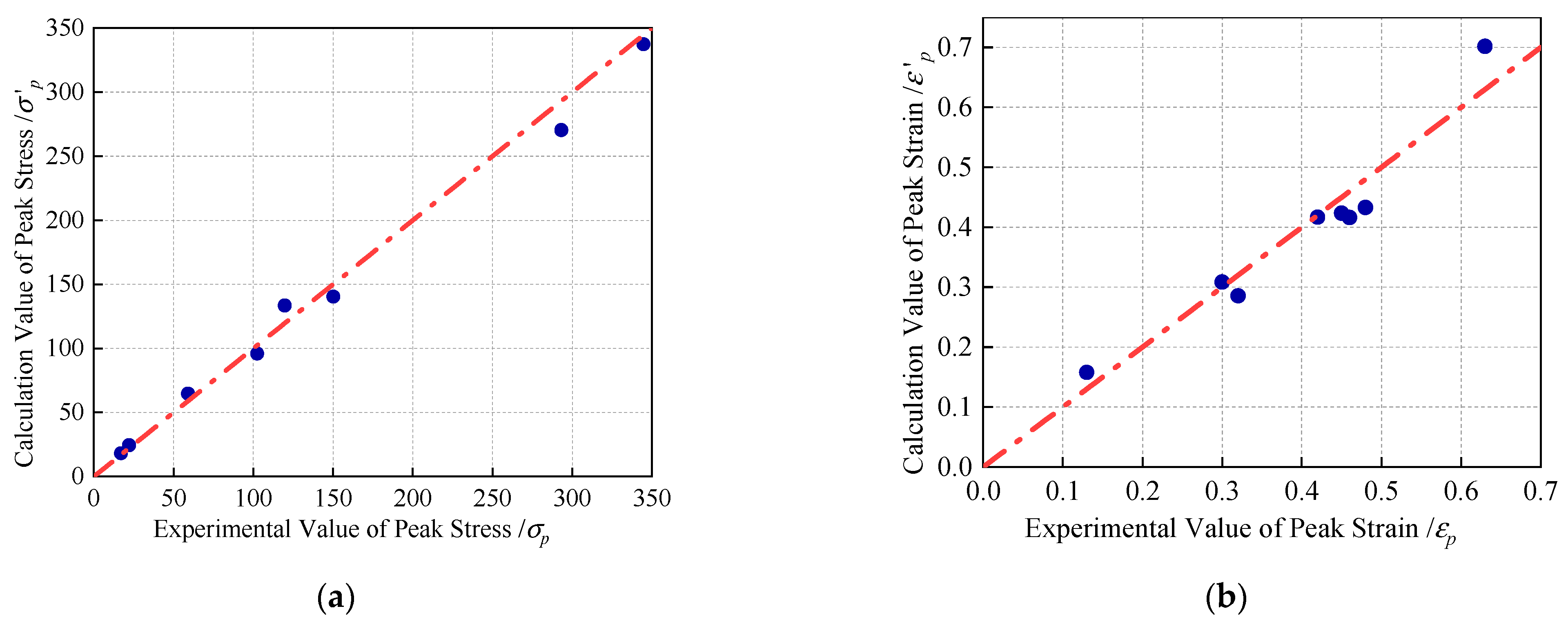3.2.1. Analysis of Stress–Strain Curves for Different Rocks
Figure 4 and
Figure 5 illustrate the stress–strain curves of granite under different temperatures and confining pressures. From
Figure 4a,f, it can be observed that the yield stage of granite is not distinct, the crack development stage is short, and the stress immediately drops after reaching the peak, resulting in failure accompanied by a noticeable cracking sound, indicative of brittle failure. When granite samples are loaded to the stress limit, they remain in the elastic stage. Under the same confining pressure conditions, the slope of the curve increases with rising temperature, while the separation between the curves at different temperatures decreases as the confining pressure increases. This is primarily due to the reduction of pores between mineral particles within the microstructure of the rock sample as the confining pressure increases, and the confining effect induced by the increase in confining pressure surpasses the thermal expansion effect caused by the rise in temperature.
As illustrated in
Figure 5, when the temperature remains constant, the stress–strain curves progressively converge with the increase in confining pressure. This indicates that granite is more sensitive to changes in confining pressure under lower confining conditions. However, once a certain confining pressure threshold is reached, the slope of the curve stabilizes, indicating that the deformation behavior of the rock tends to become consistent. Comparing
Figure 5a,e, it is evident that, at a confining pressure of 25 MPa and a temperature of 120 °C, the compressive strength and peak strain of granite are both greater than those under normal conditions. It indicates that the coupled effects of temperature and stress can enhance the density of the mineral substructure within the rock sample, thereby increasing its load-bearing capacity and improving its ductility.
Figure 6 shows the stress–strain curves of red sandstone under different temperature and confining pressure conditions. From
Figure 6a,b, it can be observed that the curves of red sandstone mainly exhibit four stages: the pore crack compaction stage, the linear elastic deformation stage, the microcrack development stage, and the post-failure stage. The nonlinear characteristics of the crack closure and compaction stage in red sandstone are not obvious, and the curve quickly enters the elastic deformation stage, showing linear variation characteristics. Comparing
Figure 6c,d, it is found that the slope of the curve in the elastic stage gradually increases. The confining pressure restricts the lateral deformation of the rock sample and the expansion of internal cracks, enhancing the closure degree of internal cracks and thus increasing the load-bearing capacity of the sample. Moreover, the compressive strength and peak strain of red sandstone decrease under high-temperature and high-pressure conditions. Higher temperatures cause a crack expansion in red sandstone, reducing its density. The influence of plastic deformation at elevated temperatures outweighs the confining pressure’s restrictive effect, thereby decreasing the sample’s load-bearing capacity. Consequently, temperature becomes the primary factor determining the compressive strength of red sandstone.
Figure 7 illustrates the stress–strain curves of gray sandstone under different temperature and confining pressure conditions. It can be observed that the curves of gray sandstone similarly exhibit the four stages of pore crack compaction, linear elastic deformation, microcrack development, and post-failure. After reaching a certain strain, the curve begins to show nonlinear growth, indicating plastic deformation and the formation of a distinct deformation region, characteristic of ductile failure. Additionally, the compressive strength and peak strain of gray sandstone significantly increases under high-temperature and high-pressure conditions, indicating that the coupled effects of temperature and stress enhance the mineral density within the gray sandstone sample, thereby improving its load-bearing capacity and ductility.
The stress–strain curves of gray sandstone under different temperature and confining pressure conditions are shown in
Figure 8. It can be observed that the curve of shale is similar to that of red sandstone and calcareous sandstone, also exhibiting four stages. As the temperature increases, the elastic modulus of the shale increases, the lateral deformation decreases, and the resistance to elastic deformation and the load-bearing capacity are improved. The compressive strength and peak strain of shale also improves under high-temperature and high-pressure conditions.
Therefore, granite demonstrates pronounced brittle failure characteristics under high temperature and pressure, with the effect of confining pressure on its deformation behavior being greater than that of temperature changes. Compared to granite, red sandstone, gray sandstone, and shale exhibit a steeper slope during the elastic phase. The elastic modulus and stiffness of these rocks increase significantly with rising temperature and confining pressure. The nonlinear increase in the curve of gray sandstone is more pronounced, demonstrating characteristics of ductile failure, which is distinctly different from the brittle failure observed in granite.
3.2.2. Analysis of Elastic Modulus for Different Rocks
Granite exhibits distinct stages of pore crack compaction and elastic deformation during loading. The transition from a concave upward shape to an approximately linear shape in the stress–strain curve serves as the boundary, allowing a separate discussion of the deformation characteristics of these two stages. The ratio of stress to strain at this boundary point is used as the deformation modulus
E of the pore crack compaction stage, determined by Equation (1). The tangent elastic modulus
Et of the elastic deformation stage is represented by the tangent slope of the linear segment of the stress–strain curve, determined by Equation (2). The determination of
E and
Et is shown in
Figure 9.
Figure 10a indicates that, as the temperature increases, the deformation modulus
E increases. In the temperature range of 40 °C to 80 °C, the slopes of the curves remain relatively low, particularly under lower stress conditions (e.g., 0 MPa and 5 MPa). This suggests that, at lower temperatures, the impact of temperature on the elastic modulus is minimal, and the stiffness of the rock does not increase significantly. Conversely, in the temperature range of 100 °C to 120 °C, the slopes of the curves increase markedly, especially under higher stress conditions (e.g., 25 MPa). During this phase, the elastic modulus exhibits a rapid upward trend as temperature rises. This behavior is primarily attributed to the enhanced interactions between mineral particles, the repair or rearrangement of crystal lattice defects, and the resulting increase in rock density and hardness under high-temperature and high-pressure conditions, leading to a significant increase in the elastic modulus. At confining pressures of 0 MPa, 5 MPa, 10 MPa, 15 MPa, 20 MPa, and 25 MPa,
E increases by 38.17%, 59.31%, 42.46%, 41.53%, 33.73%, and 34.76%, respectively, and the increment in rock deformation modulus initially rises and then levels off. At lower confining pressures, the increase in pressure compresses and closes microcracks and pores, enhancing the overall stiffness and load-bearing capacity of the rock sample. However, as confining pressure further increases, the effect of microcrack closure saturates, and the increase in deformation modulus stabilizes.
Figure 10b illustrates that the tangent elastic modulus (
Et) increases as the temperature rises. At confining pressures of 0 MPa, 5 MPa, 10 MPa, 15 MPa, 20 MPa, and 25 MPa,
Et increases by 39.09%, 40.17%, 28.82%, 21.17%, 26.92%, and 25.06%, respectively. The significant rise in
Et when the confining pressure increases from 0 MPa to 5 MPa is attributed to the compaction of microcracks and pores during the crack closure phase. As the confining pressure reaches 15 MPa, the rate of increase in
Et declines due to the formation of new microcracks or the expansion of existing ones. However, when the confining pressure increases to 25 MPa, the rate of increase in
Et stabilizes, indicating that new cracks are rapidly compressed under high confining pressure, with the rock potentially nearing its density limit.
Figure 10c shows a gradual increase in the deformation modulus
E as the confining pressure rises from 0 MPa to 25 MPa. The confining pressure causes internal pores and microcracks to gradually close, enhancing the load-bearing capacity of the rock sample and leading to an increase in deformation modulus. At temperatures of 20 °C, 40 °C, 60 °C, 80 °C, and 120 °C,
E increases by 76.51%, 78.03%, 74.74%, 71.47%, and 72.15%, respectively. When the temperature increases from 20 °C to 40 °C,
E slightly increases due to the thermal expansion effect, where the crack closure effect outweighs the expansion effect. As the temperature rises to 80 °C, the rate of increase in
E slightly declines due to the predominant crack expansion effect caused by continuous heating. When the temperature reaches 120 °C, the increase in
E stabilizes as the thermal expansion and crack closure effects balance out.
Figure 10d demonstrates a gradual rise in
Et as the confining pressure increases from 0 MPa to 25 MPa. At temperatures of 20 °C, 40 °C, 60 °C, 80 °C, and 120 °C, the increases of
Et are 44.18%, 35.33%, 33.15%, 35.18%, and 29.64%, respectively. As the temperature rises from 20 °C to 40 °C, the increase in
Et slightly declines, possibly due to most cracks and pores being compressed and closed during the crack closure phase while, in the elastic deformation phase, new microcracks induced by temperature rise affect structural integrity and reduce the rate of increase in elastic modulus. When the temperature rises to 80 °C, the increase in
Et stabilizes due to the balanced effect of thermal expansion on cracks. At 120 °C, high temperature causes the expansion of cracks and pores, influencing the trend of
Et changes and potentially altering mineral structures, leading to a decrease in the rate of increase in
Et. Obviously, confining pressure has a more significant impact on the deformation modulus during the pore crack compaction phase and on the tangent elastic modulus during the elastic phase of granite. The increase in deformation modulus with rising confining pressure is greater than that caused by temperature rise, indicating that confining pressure plays a major role in the changes in deformation modulus and elastic modulus.
The stress–strain curves of red sandstone, gray sandstone, and shale exhibit a single slope, indicating that the elastic modulus remains constant. The nonlinear characteristics of the crack closure compaction stage are not evident and, after loading, the stress–strain curves quickly transition into the elastic deformation stage, showing linear variation characteristics. Therefore, the tangent elastic modulus Et is used to represent the elastic modulus for the entire deformation stage. This value is defined as the slope of the linear segment in the stress-axial strain relationship.
Figure 11 illustrates the relationship between tangent elastic modulus and temperature, confining pressure for different rocks. From
Figure 11a,b, it can be observed that the tangent elastic modulus
Et of red sandstone exhibits significant trends with changes in temperature and confining pressure. As the temperature rises,
Et first increases and then decreases. Between 20 °C and 40 °C, the increase in temperature causes thermal expansion of minerals, which closes cracks and increases the sample’s density, leading to an increase in
Et. In the range of 60 °C to 80 °C, at low confining pressures (0–15 MPa), the increase in temperature still causes
Et to increase, while at high confining pressures (15–25 MPa),
Et remains relatively unchanged and tends to stabilize. When the temperature reaches 120 °C,
Et significantly decreases, primarily due to high temperatures causing mineral particle expansion, generating thermal stress, weakening internal bonds, and intensifying crack propagation, which reduces the elastic modulus.
Figure 11c,d indicate that the trend of
Et of gray sandstone differs from that of red sandstone. As temperature increases,
Et initially decreases and then increases. At room temperature (20 °C), when the confining pressure increases,
Et increases from 62.39 GPa to 65.18 GPa, an increase of 4.47%; at 40 °C, the increase is 7.74%; at 60 °C, the increase is 3.29%. The
Et of gray sandstone increases with confining pressure, but the rate of increase gradually decreases. This indicates that the effect of confining pressure on the closure of internal cracks in gray sandstone gradually reaches saturation. At 80 °C,
Et first decreases and then increases, reflecting the significant thermal expansion effect at high temperatures, leading to pore and crack expansion, but at high confining pressures, the closure effect dominates. At 120 °C,
Et increases with confining pressure, indicating that thermal expansion causes mineral particles to contact more closely.
Figure 11e,f illustrate that the tangent elastic modulus
Et of shale is significantly affected by temperature and confining pressure. In the range of 20 °C to 60 °C, at low confining pressures (0–5 MPa),
Et first rises and then falls, while at high confining pressures (10–25 MPa),
Et gradually rises. High temperatures cause the closure effect of internal pores and cracks in shale to exceed the expansion effect, leading to an increase in
Et.
The differing trends in the development of elastic modulus for the four rock types under varying temperature and confining pressure conditions primarily stem from differences in their internal structures and mineral compositions. Granite and shale generally exhibit an increase in elastic modulus under high temperature and pressure, reflecting the thermal stability of their structures and the effect of confining pressure on fracture closure. In contrast, red sandstone and gray sandstone show a more complex response, particularly under high-temperature conditions. Their porosity and diverse mineral compositions can lead to a decrease in elastic modulus under certain conditions.
